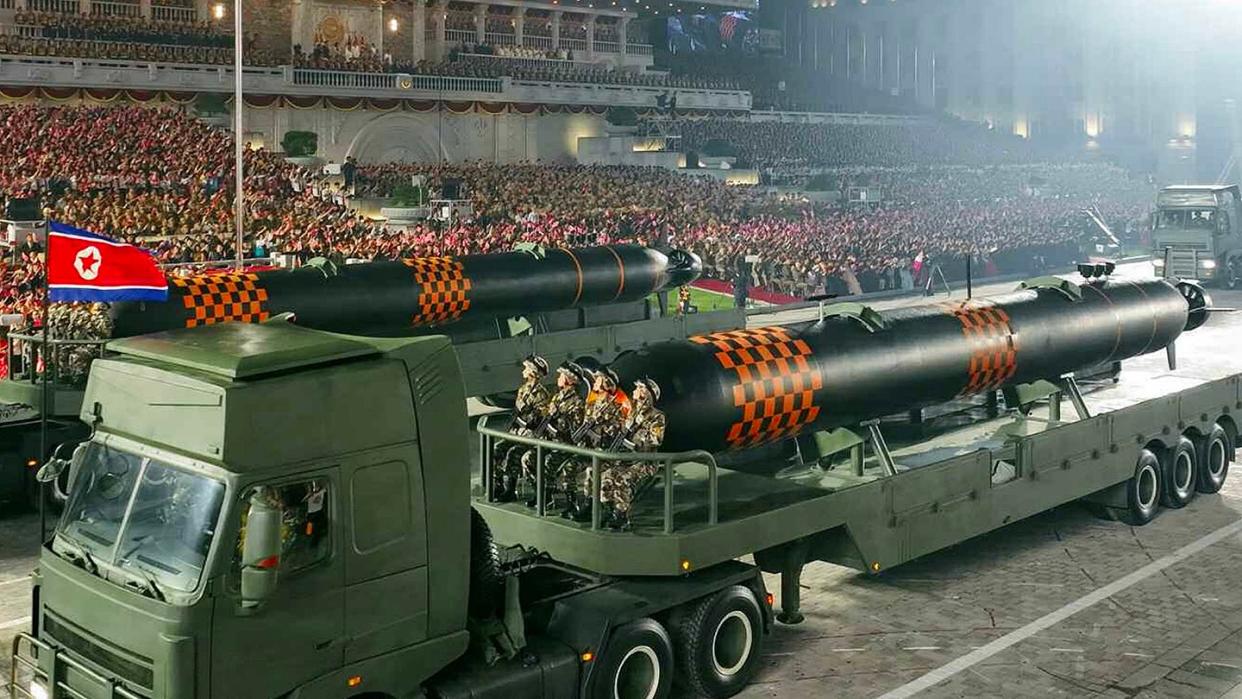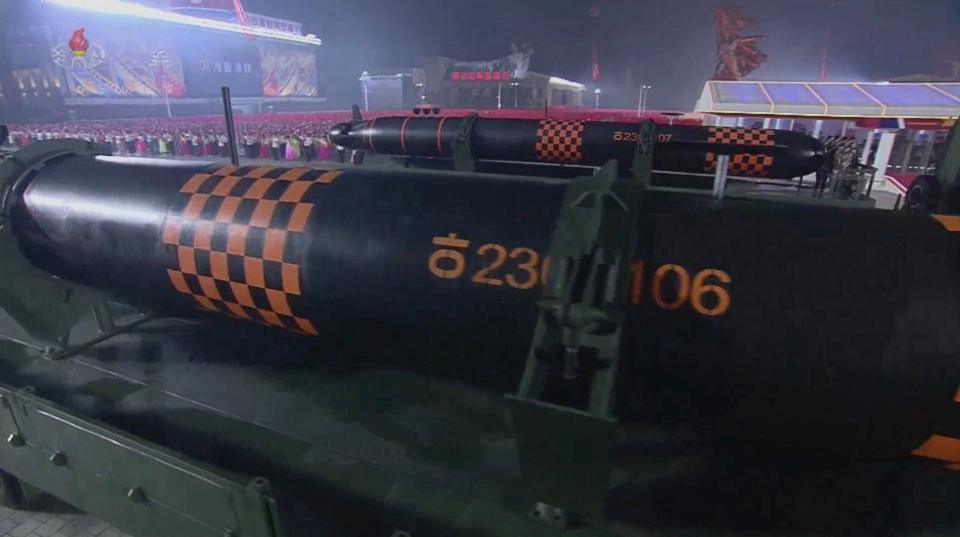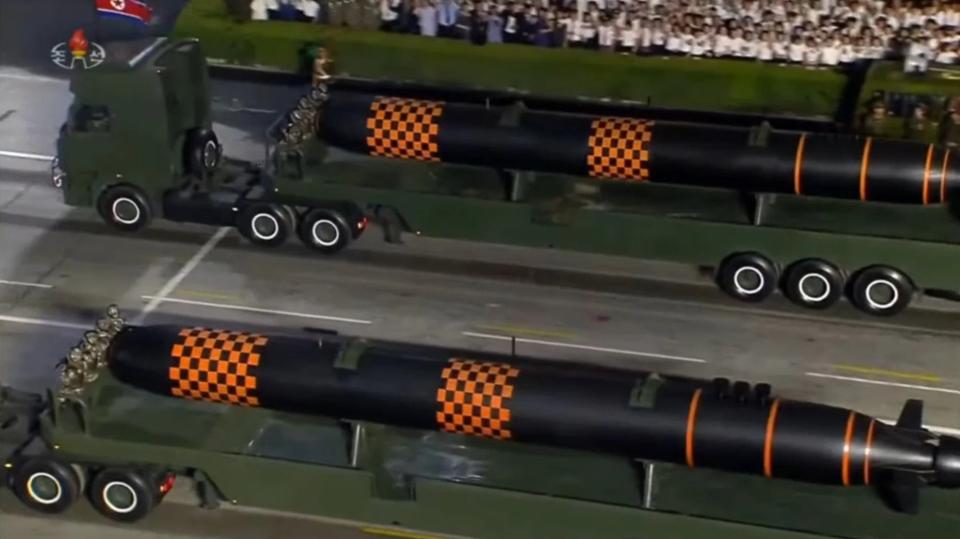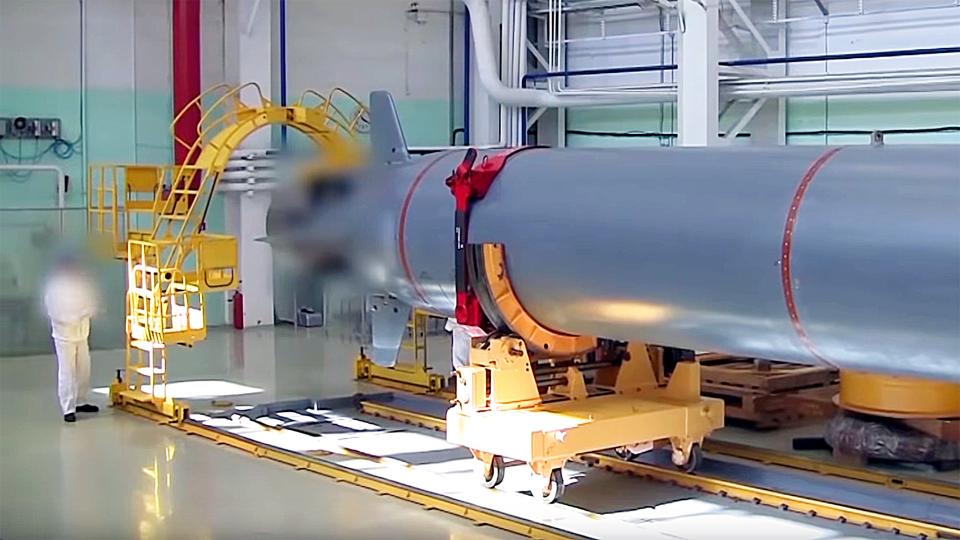North Korea’s New Nuclear Underwater Drone-Torpedo Follows Russia's Playbook

A new underwater drone, widely presumed to function much like a nuclear-armed torpedo, was revealed at North Korea’s latest military parade, in the capital Pyongyang yesterday. While new unmanned aerial vehicles were also among the highlights of the parade, the underwater drone suggests that North Korea is continuing to look at novel means of delivering nuclear warheads as it expands its strategic weapons ambitions

The underwater drones were transported on flatbed trucks through Pyongyang’s Kim Il Sung Square yesterday evening, as part of the military parade marking the 70th anniversary of the end of the Korean War.
https://twitter.com/THEEURASIATIMES/status/1684893064517791745?s=20 https://twitter.com/alistaircoleman/status/1684876822771867648?s=20 https://twitter.com/nknewsorg/status/1684743269786497025?s=20
The mysterious uncrewed underwater vehicle has been variously identified as a ‘nuclear attack drone,’ ‘uncrewed underwater vehicle (UUV),’ or ‘long-range/long-endurance nuclear torpedo.’ While it remains unclear how best to describe it, most observers agree that it is intended to carry a nuclear warhead. In this sense, it is broadly similar in concept to Russia’s Poseidon ultra-long-endurance torpedo, and also has a strategic mission.
https://twitter.com/ColinZwirko/status/1684837690465009664?s=20
In common with the Poseidon, the new North Korean drone has an apparent pump-jet propulsor at the rear and a similar arrangement of cruciform control surfaces, each of which incorporates a folding mechanism.
https://twitter.com/ISNJH/status/1684864314220650496?s=20
However, while the Poseidon features nuclear propulsion as well as a nuclear warhead, the North Korean underwater drone almost certainly relies on battery propulsion. There is no evidence, at this point, that North Korea is working on the kinds of nuclear technologies that would provide a small enough reactor to power such a vehicle. Regardless, the ranges involved with North Korea deploying such a weapon against the South, or even Japan, and even if it were to loiter for some period before attacking, are vastly less than what Poseidon was built to overcome.

The new North Korean drone is also smaller than the Poseidon which is estimated to be around 65 feet long, with a diameter of around 6.5 feet.
https://twitter.com/CollinSLKoh/status/1684855471449255936?s=20
Another major point of difference with the Poseidon is that the Russian weapon is designed to be launched by the shadowy Project 09852 Belgorod submarine — the world’s longest — while North Korea doesn’t operate any submarine large enough to serve as a mother ship. This suggests that the underwater drone would have to be launched from a dockside pier or jetty, some kind of floating platform, or perhaps a suitably modified surface vessel.
Multiple reports have identified the underwater drone as the Haeil, although this remains unconfirmed for now.
The Haeil-2 name applies to a similar but smaller underwater drone, which appeared earlier this year. At the time, it was also described by analysts as “North Korea’s answer to Poseidon.”
https://twitter.com/CovertShores/status/1684809979356741632?s=20
Based on imagery released at the time, the Haeil-2 is significantly smaller than the Poseidon and is also not nuclear-powered. H. I. Sutton, an author and an expert on submarine warfare, described it as “more like a long-ranged nuclear-armed (potentially!) torpedo. Or rather, a torpedo with uncrewed underwater vehicle (UUV) characteristics.”
Estimated data attributed the Haeil-2 with a range of up to 540 nautical miles and an average speed of 4.6 knots, notably slower than a torpedo. An operating depth of 260-300 feet was reported, too, although imagery showed it operating on the surface.
The new underwater drone that appeared in Pyongyang yesterday shares a number of attributes with the Haeil-2 and may well be closely related. However, the earlier vehicle has a different rear section, with no obvious control fins, and is smaller than the new drone.
It’s possible that the two designs represent changes introduced during the development phase of the weapon and that the newer one represents the final configuration, or simply the latest iteration before the design is finalized.
Making matters more confusing is the fact that another Haeil-type underwater drone was also shown at the Weapons and Equipment Exhibition 2023, which took place earlier this week and was attended by North Korean leader Kim Jong Un and Russian Minister of Defense Sergei Shoigu. The only image available so far suggests a vehicle that looks a lot like those seen in yesterday’s parade, although it appears to be smaller.
https://twitter.com/stoa1984/status/1684901192105631744?s=20
Either way, it’s clear that North Korea is actively working on a long-range underwater drone that is very likely intended to deliver a nuclear warhead.
With battery propulsion, North Korea’s new underwater drone will not have anything approaching the range of the Poseidon — which is effectively almost unlimited. However, its size suggests it will have a range in excess of the 540 nautical miles attributed to the Haeil-2. The kinds of targets that it can threaten will also depend heavily on exactly how it’s intended to be launched.
If, as expected, it is fitted with a nuclear warhead, it also seems likely that the new underwater drone is primarily intended to strike similar kinds of targets as the Poseidon, namely coastal installations, which it could hit with little to no warning. In such a way, it could be used to deliver a knockout blow to elements of South Korea’s expanding naval fleet before they get a chance to go to sea.
A screen capture from a Russian Ministry of Defense video showing a Poseidon during production:

Alternatively, the underwater drone could be used to attack South Korean coastal cities, especially if fitted with the same kind of ‘dirty’ warhead that has been repeatedly suggested is a feature of the Poseidon. This would ensure not only the usual thermonuclear destruction but would also spread radioactive contamination over a wide area, including potentially via the creation of large radioactive waves.
With the much smaller distances involved in a confrontation on the Korean peninsula, the more limited range of the North Korean underwater drone would be much less of an issue. At the same time, it would offer many of the same benefits as the Poseidon, being hard to detect and defend against, and, above all else, providing a strategic nuclear warhead delivery option that avoids existing missile defense systems.
An official Russian Ministry of Defense video highlighting the capabilities of the Poseidon:
https://www.youtube.com/watch?v=T_7hWSv689Q
Depending on how the underwater drone is launched, it could possibly also provide North Korea with a ‘second strike’ capability to complement its submarine-launched ballistic missiles (SLBMs). This would come into play if Seoul were to try and paralyze North Korea’s strategic nuclear forces in a first-strike scenario. At the same time, it’s worth noting that Pyongyang seems to have struggled with fielding a workable SLBM, hampered to a significant degree by the lack of a genuinely suitable submarine to launch it from. It may be that case that the underwater drone is seen as a more practical and achievable alternative to SLBMs.
A test launch of a North Korean SLBM from a submerged launcher in a lake:

Again, if intended to be nuclear-armed as predicted, the new underwater drone also provides further evidence of North Korea exploring new ways of delivering its strategic weapons, which will not only provide more strike options and a greater number of delivery systems in total but also increase the resilience of its nuclear forces in general, making them significantly less vulnerable to preemptive or counterattacks.
https://twitter.com/JosephHDempsey/status/1684491860733988864?s=20
As well as increasingly large and longer-ranged intercontinental ballistic missiles (ICBMs) plus shorter-range ballistic missiles, and the aforementioned SLBMs, in recent years Pyongyang has also demonstrated a ground-launched cruise missile, a hypersonic boost-glide vehicle, and a railcar-based missile launcher.
Aside from this nuclear role, it’s also possible that the underwater drone will help North Korea expand its UUV knowledge. Other missions for these types of vehicles could one day follow. The U.S. Navy, for example, is currently exploring the use of UUVs for sowing sea mines, which could also be of interest to North Korea, with its extensive mine warfare program. While some other roles may be beyond North Korean technological prowess at this time, the new drone could also eventually pave the way to experiments with UUVs able to perform missions like underwater surveillance or even being capable of executing cruise missile launches.
It's also worth noting that North Korea captured an American UUV back when the technology was still largely clandestine and highly experimental. That vehicle was captured over 17 years ago, near the city of Hamhung. Sutton writes:
"North Korea claimed that it was a US Navy device. At the time it was reported that the US dismissed the reports. The vehicle closely resembles the US Navy's NMRS (Near-term Mine Reconnaissance System).
The near-term mine reconnaissance system (NMRS) was an interim system until a long term system was available. The project started in the mid-1990s when covert mine reconnaissance was identified as a top priority.
Missions included remote surveillance in shallow and deep water, including precise location and classification of mine-like objects. It could also be used for [the] detection of gaps in minefields that could be exploited by covert and amphibious forces. And surveillance of coastal environments preceding an amphibious assault. A typical system had two torpedo-shaped, tethered unmanned uncrewed vehicles (UUVs). These were launched/recovered from Los Angeles class submarines via the torpedo tubes."
https://twitter.com/ChrisV3141/status/1229077826084786178?s=20
The fully intact vehicle is now displayed as a trophy next to the USS Pueblo in Pyongyang. It isn't clear exactly what North Korea gleaned from this system or if it influenced the design and technology used in the new large UUV-torpedo.
At this stage, the new underwater drone remains highly mysterious. While we await further details of this weapon with interest, it’s safe to say that it points, once again, to North Korea continuing to accelerate the development of its strategic systems as well as expand them into new modes of delivery.
Contact the author: thomas@thewarzone.com

